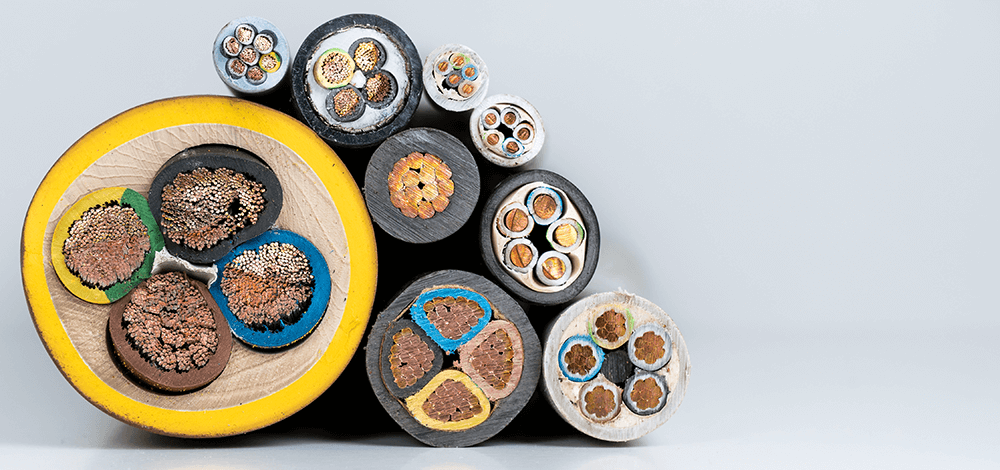If you want to lay new cables, there is often no getting around stripping. This allows the individual cores to be connected to other devices or cables. In this guide, we’ll show you the tools and how to correctly strip the insulation from the wires without damaging the internal conductors.
Whether you need to use a cable knife, cable stripper or special stripping pliers will depend on the cable type. Manufacturer Jokari provides users with a cable database to help you choose the best solution.
Fast, easy and safe stripping
You have to be careful when removing the insulation from a cable with a cable knife. If strands are cut off, this can lead to contact resistances or even to a cable fire. On top of that, there‘s the very real risk of injury with fixed-blade cable knives. A safe alternative would be a cable stripper or cable knife with adjusting screws.
A cable stripper is great for hard-to-reach places when circular cutting. The stripper is easy to close and manoeuver and allows material to be removed cleanly. We recommend using a cable stripper for longer sections like the distributor. The adjusting screw helps to set the correct blade depth.
Stripping pliers make stripping wires and strands even easier. Universal pliers with an integrated knife are brilliant for round or flat cables because you can adjust the cutting length and depth.
The differences in stripping pliers
You should only use simple stripping pliers with mechanically adjusted screws for rigid wires. Take care with thin, fine-wire conductors. Occasionally the conductor can break, which can cause bad clamping connections. We recommend using stripping pliers with an automatic scanning system. But if you prefer manual tools, make sure you can adjust the cable cross-section and length stop.
Devices with wire cutters also enable you to work quickly and cleanly. If you choose a slim design, you‘ll have no problem even in places that are difficult to access.

Quality features of stripping tools
You can use mechanical or automatic stripping pliers for cables of different cross-sections. When deciding which is best for you make sure you factor in cable cross-section and length. It‘s these functions that make the difference in price.Combination tools with side cutters and a crimping tool are also available on the market. The latter is used to connect two components by plastic deformation. They have a catch to fix the corresponding components and carry out corrective work on plugs or cable lugs without insulation. Another quality feature is the GS seal, which is awarded to products that comply with the required safety guidelines.
The right tool for hard cases
Stripping pliers are each designed for a specific cross-section range, which is usually between 0.2 mm² and 15 mm². Removing the insulation from telephone cables or very thin cables is quite simple,but the procedure for ribbon, coaxial or SAT cables requires a little more effort.The Jokari TopCoax Plus is recommended for stripping all common coaxial cables from 4.8 to 7.5 diameters or for stripping cable types such as TV-Coax, RG 58/ RG 59, PVC-Flex 3 x 0.75 mm². This tool also has an integrated socket wrench for tightening F connectors (HEX 11), so no additional equipment needs to be purchased. For PVC-insulated data communication and control cables such as Cat 5, Cat 6 and Cat 7 cables, twisted-pair and network cables or cables with thin external insulation, Jokari recommends the PC-CAT stripper. There’s no need to adjust the cutting depth to the diameter, as the special blade is positioned perfectly to remove the outer insulation, then the foil shield can also be scored and removed.
Stripping blade for particularly thick cables
You should use a stripping blade for any particularly thick cables like underground cables. An integrated adjusting screw makes it possible to switch automatically from round to longitudinal cut. Although more physical effort is required here than with the wire stripper, the risk of damaging electrical wires is much lower.Jokari has a cable knife system in its portfolio. This can be used to strip wires from 4 to 70 mm in diameter in no time at all due to its interchangeable iron system. Security is guaranteed as the titanium nitride-coated hook blade is not activated until the protective mechanism provided for it is pushed back.
The special coating ensures a faster cutting speed and less wear. The cutting depth of the knife can be altered by adjusting the screw, depending on the thickness of the sheath. For recurring insulation thicknesses, additional markings are there to help with adjustment.
Micro-precision stripper for delicate cases
For stripping cables in electronics, telecommunications and model making manufacturer Jokari has designed a product range to tackle difficult insulation materials. The range makes it easy to strip PVC, Teflon, Kynar, Tefzel, Mylar. The PWS-Plus has an adjustable working range, the SWS-Plus has a fixed diameter for series use and the ESD-Plus is great for electrostatically sensitive areas. The working range covers all common conductors from 0.12 to 1.0 mm diameter (AWG 36-18).
Images: Adobe Stock














